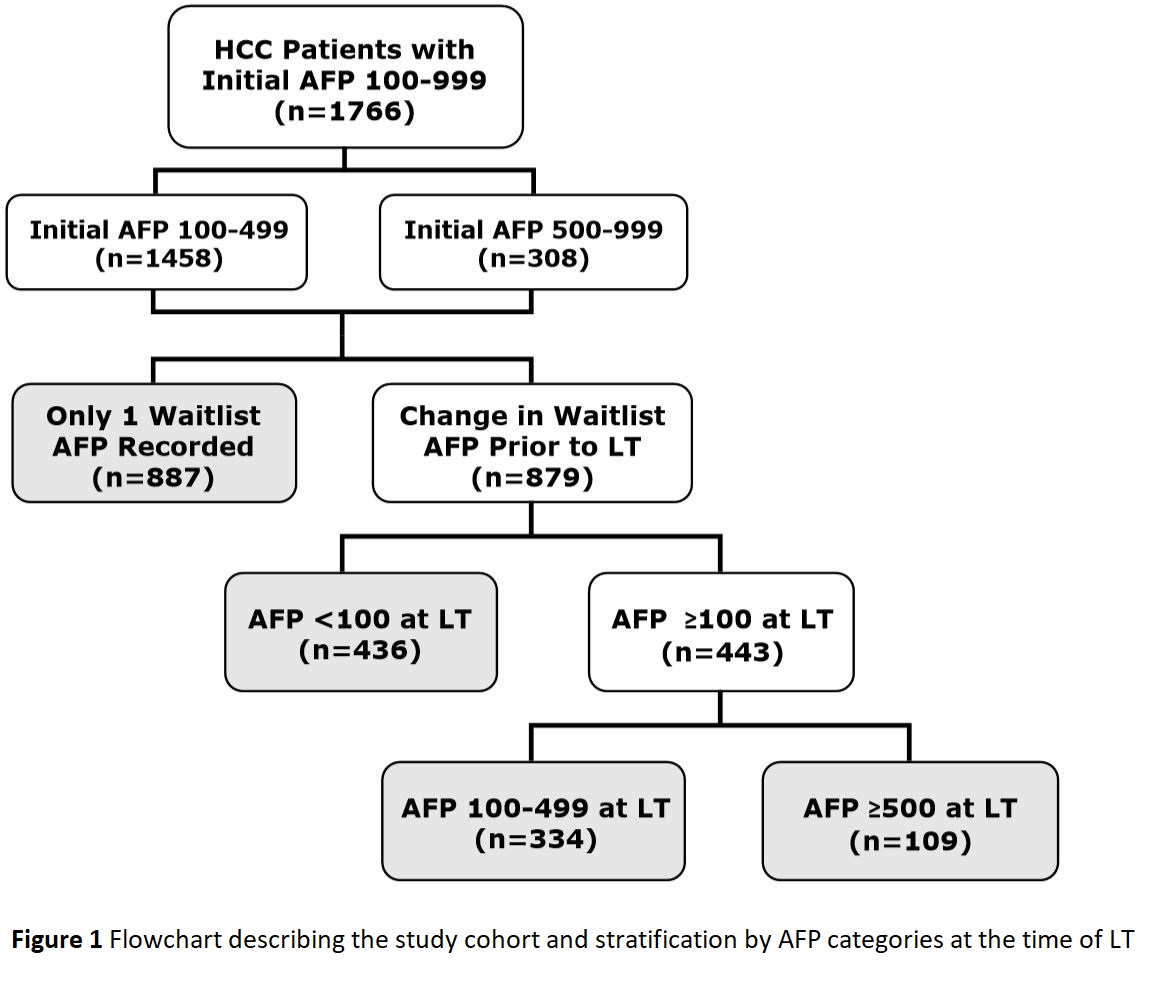The Impact of Initial Alpha-Fetoprotein >100 but <1,000 ng/mL and Pre-Transplant alpha-Fetoprotein Reduction on Outcomes after Liver Transplant in Patients with Hepatocellular Carcinoma
1Department of Medicine, UCSF, San Francisco, CA, 2Department of Medicine, USC, Los Angeles, CA
Meeting: 2020 American Transplant Congress
Abstract number: B-138
Keywords: Hepatocellular carcinoma, Liver transplantation, Mortality, Tumor recurrence
Session Information
Session Name: Poster Session B: Liver: Hepatocellular Carcinoma and Other Malignancies
Session Type: Poster Session
Date: Saturday, May 30, 2020
Session Time: 3:15pm-4:00pm
 Presentation Time: 3:30pm-4:00pm
Presentation Time: 3:30pm-4:00pm
Location: Virtual
*Purpose: Under current UNOS policy, hepatocellular carcinoma (HCC) patients with alpha-fetoprotein (AFP) >1,000 ng/mL are required to show a reduction in AFP to <500 ng/mL with local-regional therapy (LRT) before liver transplant (LT). We hypothesized that both of these AFP thresholds should be lowered to further improve LT outcome. We therefore aimed to evaluate the effects of AFP reduction on post-LT HCC outcomes among HCC patients with initial AFP >100 but <1,000 ng/mL.
*Methods: We identified 1766 HCC patients in the UNOS registry who underwent LT from 01/2005 to 09/2015 with initial AFP of 100 to 999 ng/mL at listing with MELD exception. Patients were grouped by AFP within 3 months of LT of <100, 100-499, and ≥500 ng/mL. Survival was compared using the Kaplan-Meier method. Factors associated with post-LT survival and HCC recurrence were assessed in a multivariable Cox regression model.
*Results: Among 1766 included patients, the initial AFP was 100-499 in 1458 (83%) and 500-999 in 308 (17%) patients. For 887 patients (50%) this was the only AFP value recorded while on the LT waitlist. In the remaining 879 patients, 436 (50%) had an AFP reduction to <100 at LT and 443 (50%) had an AFP ≥100 at LT, including 109 (12%) with AFP ≥500. LRT was reported in 91% of patients with AFP <100, 83% with AFP 100-499, and 69% with AFP ≥500 at LT (p<0.001). The median wait time was shortest in the group with only a single AFP and longest in the group with AFP <100 at LT (1 versus 7 months, p<0.001). The 5-year post-LT survival was 73% for AFP <100, 70% for AFP 100-499, and 56% for AFP ≥500 at LT (log-rank p=0.003). The probability of HCC recurrence at 5 years was 13%, 19%, and 24%, respectively (log-rank p=0.007). In multivariable analysis, AFP ≥500 at LT was associated with a greater risk of post-LT death (HR 1.4, 95% CI 1.1-1.9, p=0.02) and HCC recurrence (HR 1.6, 95% CI 1.0-2.4, p=0.05) when compared to AFP <100 at LT, after adjusting for donor risk index, age, race/ethnicity, Child’s class, and tumor diameter at LT.
*Conclusions: In HCC patients with initial AFP > 100 and <1,000 ng/mL at LT listing, those with AFP >500 ng/mL at LT had a 5-year post-LT survival of only 56%, versus 73% for those achieving AFP reduction to <100 ng/mL at LT. Our results suggest that the AFP threshold of >1000 ng/mL for exclusion from LT in the current UNOS policy may be lowered to >500 ng/mL, with a target AFP reduction to < 100 ng/mL, to further optimize post-LT outcomes.
To cite this abstract in AMA style:
Goldman ML, Zhou K, Dodge JL, Yao F, Mehta N. The Impact of Initial Alpha-Fetoprotein >100 but <1,000 ng/mL and Pre-Transplant alpha-Fetoprotein Reduction on Outcomes after Liver Transplant in Patients with Hepatocellular Carcinoma [abstract]. Am J Transplant. 2020; 20 (suppl 3). https://atcmeetingabstracts.com/abstract/the-impact-of-initial-alpha-fetoprotein-100-but/. Accessed December 17, 2025.« Back to 2020 American Transplant Congress

